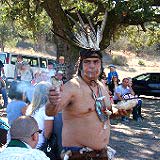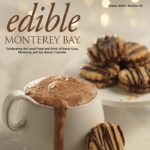 Randall Grahm never takes the selection of a name lightly, so years after purchasing a new vineyard site in San Juan Bautista, he used the occasion of his 9th annual Day of the Doon winemaker’s farm-to-table extravaganza on Sunday to announce his choice of a moniker for the ranch. He will call it “Popelouchum” (pronounced: popa-low-shoom), a word meaning both “the village” and “paradise” in the language of the Mutsun people, a local indigenous tribe.
Randall Grahm never takes the selection of a name lightly, so years after purchasing a new vineyard site in San Juan Bautista, he used the occasion of his 9th annual Day of the Doon winemaker’s farm-to-table extravaganza on Sunday to announce his choice of a moniker for the ranch. He will call it “Popelouchum” (pronounced: popa-low-shoom), a word meaning both “the village” and “paradise” in the language of the Mutsun people, a local indigenous tribe.
Grahm also disclosed that he’s in talks to lease property and plant his signature Rhone varietals back in Bonny Doon, which is where his winery started in 1983. “How can I be a terroir-driven winemaker, call my company Bonny Doon Winery and not have vineyards there?” he reasoned.
True to its new name, the hilly, oak-studded, 280-acre property in San Juan Bautista was indeed a paradise for the 150 gathered devotees of Bonny Doon’s unique wines. Tasting started before the bus from Santa Cruz even pulled out of the driveway. On the way to San Juan Bautista we enjoyed a dry 2009 Muscat in paper cups—just to get the party started.
On arrival, the invited guests, members of the Bonny Doon wine club, were greeted with a purification ceremony and Native American dances performed by the Amah-Ka-Tura dance troupe of Watsonville—which includes Ohlone, Coastanoan and Chumash members. The Mutsen, whose language will live on in the name of the vineyard, were a band of Ohlone Indians who lived in the mission at San Juan Bautista some 200 years ago.
The hot and dusty afternoon was refreshed by tastings of ¿Querry?, a sparkling pear, apple and quince hard cider and Sparkling Muscato served in champagne flutes, which we sipped as we toured the 5-acre vegetable garden. Grahm is experimenting with the use of biochar, a form of charcoal, in the vegetable beds. Gardeners at the ranch have been mixing biochar into compost at a ratio of 8 tons per acre or about a one-inch layer mixed into growing beds. It works to increase the water holding capacity by 25-30%, he says. It also helps make the nutrients in the soil more accessible and sequesters carbon—which counteracts global warming.
Grahm is such an evangelist for biochar that his young daughter piped up at one point suggesting that the property be named “biochar land.” But the proof is in the tasting. We tried tomatoes grown with biochar mixed into the soil and those without. Those from the biochar garden were unmistakably more intensely flavored and more delicious—especially a small green-tinged variety called Japanese Trifle. Grahm calls the effect “terroir on steroids” and hopes it will work equally well on the vineyards he is planting there.
You can taste produce grown with biochar by dining at the Cellar Door, Bonny Doon’s restaurant in Santa Cruz, or by purchasing it at a small produce stand that has been set up inside the tasting room. You can learn more about Randall Grahm’s experiments at his San Juan Bautista property and his plans to create completely new grape hybrids and a unique American vin de terroir in the fall issue of Edible Monterey Bay Magazine. (Find distributors or read online.)
As the sun set on the Day of the Doon, we enjoyed a vertical tasting of Le Cigare Volant vintages 2005, 2003 and 2001 and sat down to a spectacular dinner prepared in the wild by Cellar Door executive chef Jarod Ottley.
The meal began with Halibut, Skipjack and Kampachi sashimi and cold melon paired with 2010 Roussane Viognier—opening the appetite perfectly. Next came platters of tomato centers and creamy burrata cheese with herbs, with a 2009 rosé called “A supposedly clever…”. The verdict: beyond clever, this was an inspired pairing.
For the main course, chef Ottley prepared meltingly tender braised short ribs on a bed of roasted vegetables in horseradish sauce, accompanied by 2005 Pinot Noir normale. And although everyone complained about being too full, we all lined up for a turn at the cheese table and a final glass of dessert Mouvèdre “Mon Doux”.
When Grahm announced he was in discussions to lease property and plant Rhone varietals in Bonny Doon again, his guests received the news with whoops and hollers, perhaps providing a sign that the Native American magic is already at work. — Deborah Luhrman
About the author
At Edible Monterey Bay, our mission is to celebrate the local food culture of Santa Cruz, San Benito and Monterey Counties, season by season. We believe in sustainability, and we believe everyone has a right to healthful, clean and affordable food. We think knowing where our food comes from is powerful, and we hope our magazine, website and newsletters inspire readers to get to know and support our local growers, fishers, chefs, vintners and food artisans.
- Edible Monterey Bayhttps://www.ediblemontereybay.com/author/ediblemontereybay/
- Edible Monterey Bayhttps://www.ediblemontereybay.com/author/ediblemontereybay/
- Edible Monterey Bayhttps://www.ediblemontereybay.com/author/ediblemontereybay/
- Edible Monterey Bayhttps://www.ediblemontereybay.com/author/ediblemontereybay/



